Bee Fencing Project
Butterfly Pavilion supports the spread of beehive fencing to new communities in Africa to mitigate human-elephant conflict.
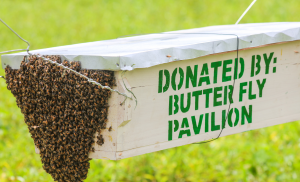
The Bees for Elephants project is transforming the way rural communities coexist with wildlife. For generations, farmers living near National parks or elephant corridors have struggled with a devastating challenge: elephants raiding their crops and water sources. These massive animals, while majestic and vital to the ecosystem, can destroy water systems or an entire season’s harvest in a single night, leaving families without fresh water, food, or income for months. In extreme cases, these encounters can even turn deadly for both the people and the elephants, as frightened farmers attempt to defend their livelihoods. With limited resources and few alternatives, many villages have faced the heartbreaking choice between survival and conservation.
Elephant deterrent methods such as electrical fences, thorn barriers, loud noises, fire, and gunshots have been used in an attempt to mitigate human-elephant conflict. However, these methods are often difficult to sustain in the long-term and elephants quickly find ways around them.
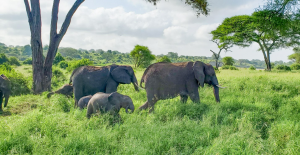
Invertebrates to the Rescue
A simple yet powerful solution is changing everything, thanks to the African honeybees (Apis mellifera scutellata). Bee hives represent a natural human-elephant conflict mitigation tool that has been proven successful and sustainable in the form of beehive fencing. Beehive fencing (developed by Dr. Lucy King of Save the Elephants) uses hanging beehives around crops and homes to deter elephants from entering areas.
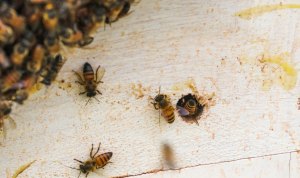
But how do bee fences work?
Basically, the Bees are acting as nature’s peacekeepers in this conflict. Elephants have an instinctive fear of bees, avoiding them to avoid painful stings in sensitive areas like up their trunks, eyes, and ears. The Bees for Elephants project leverages this natural deterrent by installing beehive fences, a series of connected hives that create a living, aggressive and buzzing barrier around farmlands. When elephants approach and disturb them, the bees emerge, encouraging the elephants to go away before damage is done. African honeybees will readily send thousands of worker bees out to sting intruders. Even the sound of bees swarming causes elephants to run away and, overtime, they learn to avoid these bee-fenced areas and teach their family groups to do the same.
This nature-based solution is not only effective but also provides life-changing benefits for the local people and ecosystems involved.
Besides defending against elephants, beehive fences provide the benefits of being easily managed by people within the community, involving locally available materials, providing pollination to crops, and providing a supplemental income to farmers through the sale of wax and honey. As such, maintaining hives provides an opportunity for local livelihood enhancement. It is estimated that, within three years of fence construction, communities become self-sufficient in maintaining the fences and selling the honey, propolis, and wax harvested from the hives.

Timeline:
In 2018, Butterfly Pavilion launched the Bee Fencing Project in collaboration with the Katie Adamson Conservation Fund (KACF), Denver Zoo, and the Health and Environmental Management Society (HEMS) in Nepal. Butterfly Pavilion traveled to a community just outside of Nepalgunj, Nepal, adjacent to Bardia National Park to establish beehives. Butterfly Pavilion experts trained community members in beekeeping techniques.
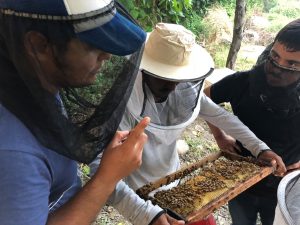
In 2019, Butterfly Pavilion expanded our Bee Fencing Project to Tanzania. Butterfly Pavilion experts traveled to Lamadi, Tanzania, near Serengeti National Park, to donate beekeeping equipment, build hives, and train community members in beekeeping.

Between 2021 and 2024, we began planning with the Tanzanian Elephant Foundation to expand our Bees for Elephants Program to communities outside of Nyerere National Park in southern Tanzania and Mkomazi National Park in northern Tanzania. In 2022, we started a 4.5-kilometer beehive fence in Kisiwani, Tanzania to protect crop fields from elephants entering the community from Mkomazi National Park. Wild honeybee colonies occupied the hives within only just hours of hanging them! We also added new hives to a beehive fence in Kisemo and pulled honey frames from a beehive fence in Kisaki. We supported beekeeping training in these three communities and donated beekeeping equipment to Kisiwani so that they can safely manage their fence and hives.
Currently, we work with five villages, where beehive fences range from 1 km to 4.5 km in length, protecting farms and providing economic opportunities through the production of beekeeping products, such as honey, wax, and propolis. To date, we have installed 990 hives with 254 occupied with bees. As a result, conflicts have dropped by well over 80% ad honey production has soared, with over 600 kg of honey harvested so far, creating new financial stability for families. Additionally, through training programs, we empower local beekeepers, equipping them with skills in hive management, honey production, and product diversification, further strengthening economic resilience.
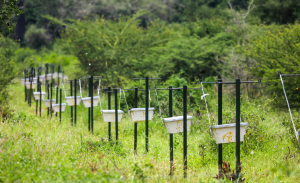
Last but not least: A Model for Conservation Success
Butterfly Pavilion saw the great potential of beehive fencing to not only protect elephants, but also promote the conservation of native honey bee species and pollinator habitat in communities in Africa.
This initiative is proving that people, pollinators, and wildlife can thrive together. By reducing human-elephant conflict, we are preventing elephant deaths caused by retaliation while fostering a culture of coexistence. At the same time, our work is promoting pollinator conservation—critical for maintaining healthy ecosystems and agricultural success. This model has the potential to expand across Africa, offering a replicable blueprint for other communities facing similar challenges.
African honeybees are native to Tanzania, and by fostering love, care and respect for them we accomplish one of our most important missions at Butterfly Pavilion. Enhancing the future of these small feisty but vital pollinators in Africa.
By investing in bee fences, we are not just protecting crops. we are securing livelihoods, conserving pollinators, and ensuring the future of one of Earth’s most iconic species.
Your support can help expand our impact, bringing this innovative solution to more villages and ensuring a future where elephants and communities can thrive together.
Photos by Rich Reading
Thank you to our Partners:

Want to learn more about our Bee’s For Elephants Project? Check out some of our articles on Bee Fencing below.
Q&A with Rich Reading About Bees for Elephants – Feb 1, 2024
Butterfly Pavilion’s Trip to Tanzania – Oct 3, 2022
Bees For Elephants Program: A Tanzania Project Summary – March 22, 2022
Bees For Elephants – March 4, 2022
Bee Fencing Project: A Global Impact – Sept 22, 2021
The Best Defense is a Good Bee Fence – July 31, 2019
Bee Fencing to Protect People and Elephants – Dec 18, 2018



